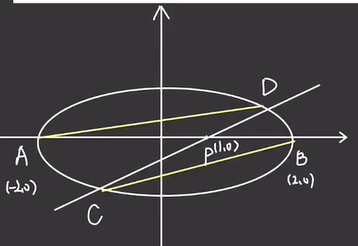I 解析几何临时例题
Problem I 【非对称韦达】
【Description】已知椭圆 x24+y2=1,其长轴上两定点为 A(−2,0),B(2,0)。过 P(1,0) 作直线交椭圆于 C,D 两点,证明:kAD⋅kBC 为定值。

椭圆的第三定义:kPA⋅kPB=e2−1
貌似可以 参与运算??
【Solution】
网上给了 n 中解法,自己发现可以先设 ℓAD,ℓBC 的斜率为 k1,k2,然后用 k1,k2 表示 xD,yD,xC,yC,由 C,D,P 共线得 yDxD−1=yCxC−1,带入并因式分解得到 (4k1k2+1)(3k1−k2)=0。前者为椭圆的第三定义,那么取后者 k1k2=13。
Problem II 【齐次化-平移】
【Description】已知椭圆 x26+y23=1,其上有定点 A(2,1)。过 A 引两条互相垂直的直线 ℓAM,ℓAN 交椭圆于 M,N。过 A 作 ℓAD⊥ℓMN 交 ℓMN 于 D。证明有定点 Q 满足 |DQ| 为定值。
【Solution】本题是齐次化 - 平移例题。
将坐标系原点平移至 A。设 ℓMN:mx+ny=0。带入使用齐次化惯用手段得到 m+n+34=0,解出过的定点是什么。
但是我们可以这样做:因为 D 在一个圆上,而从 D 出发已经有两条垂直的直线,那么就是说如果能在这两条直线上分别找两个定点,就可以构出斜边中线(可以证明这是充要的)。所以我们要做的就是找出 ℓMN 过哪一个定点 P,构出 ΔADP 的斜边中线。
设其过的定点为 P(x0,y0),并设 ℓMN:y=k(x−x0)+y0。那么我们将 ℓMN 与椭圆联立。根据 ℓAM⊥ℓAN 列式 yM−1xM−2⋅yN−1xN−2=−1,发现该式对称,那么利用韦达定理算出 xM+xN,xMxN,yM+yN,yMyN 关于主元 k 和参数 x0,y0 的式子,得到 (9x20−24x0+12)k2+(−18x0y0+24y0+6x0)k+9y20−6y0−3=0。该式子可看成关于 k 的二次方程,对于任意 k 都有上式成立,则 ⎧⎪⎨⎪⎩9x20−24x0+12=0−18x0y0+24y0+6x09y20−6y0−3。解得 P(1,2)(舍)或 P(23,−13)。故 Q(43,13)。
Problem III ?
【Description】椭圆 x24+y23=1。椭圆上一点 P,过 P 作椭圆的切线交直线 x=4 与 Q。证明存在一定点 D,满足 ℓPD⊥ℓQD。
Problem IV ???
过椭圆外一点 P 引椭圆的两条割线 ℓAC,ℓBD,且 ℓOP 过弦 AB 的中点。求证:ℓAB∥ℓCD。
II
- T1
- cos(A+2B)+cosA=sin2B
- 求 min{4a2+5b2c2}
- T2
- 锐角 ΔABC,cos2B−cos2A=4(cosC−cos3C)
- 求 ab+b2c2 取值范围
- T3
- 锐角 ΔABC,角 A,B,C 的对边依次为 a,b,c,满足 2SΔABC=a2−(b−c)2。求 4b2−12bc+17c24b2−12bc+13c2 的取值范围。
- 答案:(281181,2]
三角
- 化边或化角?
- 看证什么?
- 证角就化角,因为边证不了角
- 如果考虑化边(转为 a,b,c 的式子)那么就基本上就是用正弦、余弦等等。
- 代数化简
- 原则:多倍化同倍,异名化同名,往待证的方向化简(如果没有直接的待证那么就当是要得到一个强力的角度关系)
- 和差化积:一堆复杂的角的和差的同名三角函数加减,像 cos(A+2B)+cosA=sin2B
- 一个 trick:题目中给了角或边可以将值带入调节次数。
III −−−−−−−−−−→Derivative
Problem 1
Description
f(x)=lnx+ax
- 若不等式 f(x)≥2−ex+a 对于 x>0 恒成立,求 a 范围。
Solution
必要性探路:取 x=1 和 x=e,得到 a≤2。
求导,f′(x)=1x−e−2+ax2,极值点 x0=e−2+a。带入 f(x0)≥0 求解即可。
Problem 2
Description
证明:对 ∀a∈(0,1),存在 b>0 使得 aeb=a+b,且 2lna+b<0。
Solution
画图,得到大致图像,确定方程有唯一合法解。
利用方程消元,a=beb−1,b 为原方程的零点,取值范围为 (0,+∞),问题转化为证明 2lnbeb−1+b<0,即证 ∀x>0,x2ex<(ex−1)2。
写出函数 g(x)=e2x−(2+x2)ex+1,g′(x)=2e2x−(x2+2x+2)ex=2ex(ex−12x2−x−1),经典不等式放缩得 g′(x)>0,带入端点原式得证。
Problem 3
Description
f(x)=exln(x+1),证明:对 ∀x,t∈(0,+∞),有 f(x+y)>f(x)+f(y)。
Solution
思路:选取主元,证明不等式大于零(显然构造的函数是单调的)
令 x<m,构造 g(x)=f(x+m)−f(x),则 g(x)=ex⋅(em⋅ln(x+m+1)−ln(x+1)),即证 (em⋅ln(x+m−1)−ln(x+1)),即政 h(x)=em⋅ln(x+m−1)−ln(x+1)。
求导,h′(x)=emx+m+1−1x+1,易证 h′(x)>0。得证。
Problem 4
Description
同 Problem 3
Solution
Problem 5
Description
证明:exlnx−1+2ex−1x>0
Solution
直接求导,发现零点没法弄,带入了几个点发现都取不到等去,于是考虑是不是没卡死的不等式,考虑放缩。
初步化简:即证 lnx+2ex>e−x
画图,发现的确没卡死,那么考虑“隔离折线”。但是不好操作。
变一下,即证 xlnx>xex−2e,隔离直线 y=−1e。
一般在隔离直线的时候,函数的凹凸性得考虑一下。
放缩解法:
lnx−1ex+2exex≥ex⟶≥lnx−1ex+2ex=lnx+1ex>0
⋆ Problem 6
Description
证明:对 ∀x>1 有 ex−x4+3x3lnx−x2≥0
Solution
⇔exx3−x+3lnx−1x≥0⇔ex−3lnx−(x−3lnx)≥1x⇔et−t≥1x
et−t≥1≥1x
得证。
Problem 7
Description
证明:a≤1 时有 xex−ax≥lnx+1
Solution
xex−ax≥xex−x
即证 xex−x+lnx−1≥0
同构,xex−ln(xex)≥1⟶t−lnt≥1 得证。
Problem 8
Description
证明:对 ∀a≥1 有 aex−x−a>xlnx−sinx
Solution
放缩参数,只需证明 a=1 时成立即可。
即证 ex−x−1−xlnx>−sinx
设 f(x)=ex−1−x−xlnx,求导,f′(x)=ex−2−lnx=0,f′′(x)=ex−1x。设 f′′(x)=0 的根为 x0,则 x0ex0=1,对 f′(x0) 的式子进行替换,f′(x0)=1x0−2+x0≥0,即 f′(x)≥0,f(x) 单增。
隔离折线,只需证明 x∈(0,π] 时 ex−x−1−xlnx>0>−sinx,x∈(π,+∞) 时 ex−x−1−xlnx>1>−sinx 即可。
得证。
Problem 9
Description
证明:1−lnxex+2x2−1x<2 在 x∈(0,1) 恒成立。
Solution
一眼 · 丁真,鉴定为:
1−lnxex+2x2−1x<1−(lnx+1x)+2x2
x∈(0,1)→⎧⎨⎩lnx+1x>12x2<2
得证。
Problem 16
Description
f(x)=ex+1+ax+a
- 若 x≥0 时,f(x−1)+ln(x+1)≥1,求 a 取值范围。
Solution
g(x)=ex+ax+ln(x+1)−1,g′(x)=ex+a+1x+1。
端点效应,带入 x=0,g(0)=0,则 g′(0)≥0,解得 a≥−2。
若 a≥−2,则 g′(x)=ex+a+1x+1≥0。带入 x=0 得 g(0)=0。
答案为 a≥−2。
link
Problem 1
Description
f(x)=(x−1)lnx−a(x+1) 有两个零点 x1,x2。
- 求 a 的范围。(答案:a>0)
- 证明 1lnx1−a+1lnx2−a>0
tag:极值点偏移、预处理变形
Solution
{(x1−1)lnx1=a(x1+1)(x2−1)lnx2=a(x2+1)→⎧⎪
⎪⎨⎪
⎪⎩lnx1=a⋅x1+1x1−1lnx2=a⋅x2+1x2−1
1lnx1−a+1lnx2−a=x1−12a+x2−12a>0→x1+x2>2
这样子代?
Problem 2
Description
f(x)=aex−1−lnx+lna
- 若 f(x)≥1,求 a 取值范围。
Solution
- 同构。
- ex+lna−1+x+lna−1≥elnx+lnx
- 普通
- f′(x)=0,解得 x=x0,满足 aex−1=1x
- 然后把 a 代成 x0,发现刚好代完了。
- 于是 f(x0) 与 a 脱离了关系,直接求即可。
- 还有。
Problem 3
Description
证明 n∑k=11√k2+k>ln(n+1)
Solution
首先常规数列不等式的套路,转化为证 1√x2+x>ln(x+1)−lnx
这怎么证?????????????
瞎几把想ing
看一下均值不等式 √ab<b−alnb−lna?
我去!做出来了!
√x(x+1)<(x+1)−xln(x+1)−lnx
还没看其他方法。
Problem 4
Description
f(x)=x−12sinx−m2lnx+1
- 若存在 x1,x2∈(0,+∞),且 x1≠x2,f(x1)=f(x2),证明:x1x2<m2
Solution
这个东西取小于号和小于等于号有什么猫腻?
首先尝试极值点偏移,但是发现 m 根本不是极值点!
那然后呢?不能用极值点的构造对称,那么要证明不等式成立,说明很可能并不是要取到等(卡死),而是能够放缩,而且正好三角函数基本是放缩。
于是只能模仿代数消元,先写关系式:
⎧⎪
⎪⎨⎪
⎪⎩x1−12sinx1−m2lnx1+1=Tx2−12sinx2−m2lnx2+1=T
x2−x1−12(sinx2−sinx1)=m2(lnx2−lnx1)
运用三角函数放缩 x>sinx 得 m2(lnx2−lnx1)=x2−x1−12(sinx2−sinx1)>12(x2−x1),然后对数均值不等式悬而击之。
#include <bits/stdc++.h>
using namespace std;
const int N = 1e5 + 5;
signed main() {
}
Problem 4
Description
f(x)=ax−lnx,关于 x 的方程 f(x)=0 有两个不相等的实数根 x1,x2,其中 x1<x2。
- 求实数 a 的取值范围。
- 设 k 为常数,当 a 变化时,若 xk1x2 有最小值 ee,求常数 k 的值。
Solution
一眼看过去,式子极其丑陋,那么考虑列出方程组作代换,凑 xk1 出来。
{kax1=lnxk1ax2=lnx2
于是 a(kx1+x2)=lnxk1x2≥e
消去 a,得到 a=lnx2−lnx1x2−x1
带入,齐次化,设 t=x2x1,得到 lnt⋅t+kt−1≥e
那么问题转化为:已知定义域为 (1,+∞) 的函数 f(t)=lnt⋅t+kt−1 最小值为 e,求 k.
啊???
答案:k=e2−2e
Problem 5
Description
f(x)=ex−x,g(x)=x−lnx
- 证明存在一条直线 y=b,使得该直线与 f(x) 和 g(x) 的图像共有三个交点,且交点的横坐标呈等差数列。
Solution
这不来一手同构?
画个图,发现 y=b 必然交在 f(x) 和 g(x) 的交点处。
大概判断一下零点的大小关系,得 x1<0<x2<1<x3
然后同构大显身手!ex1−x1=b,ex2−x2=b,x2−lnx2=b
那么得 ex1−lnex1=b,所以 ex1=x2 或 x3。由根的所在值域得 ex1=x2。同理 lnx3=x2。
即证 ex2+lnx2=2x2。结合前面的式子易证。
Problem 6
Description
已知 {alnx1=2x1−3alnx2=2x2−3,求当 x2x1 最小时 a 的值。
Solution
先消元得到 lnx12x1−3=lnx22x2−3,然后设 x2=t⋅x1,带入尝试各种操作看能不能分离,发现可以,完结。




【推荐】国内首个AI IDE,深度理解中文开发场景,立即下载体验Trae
【推荐】编程新体验,更懂你的AI,立即体验豆包MarsCode编程助手
【推荐】抖音旗下AI助手豆包,你的智能百科全书,全免费不限次数
【推荐】轻量又高性能的 SSH 工具 IShell:AI 加持,快人一步
· 分享4款.NET开源、免费、实用的商城系统
· 全程不用写代码,我用AI程序员写了一个飞机大战
· MongoDB 8.0这个新功能碉堡了,比商业数据库还牛
· 白话解读 Dapr 1.15:你的「微服务管家」又秀新绝活了
· 记一次.NET内存居高不下排查解决与启示